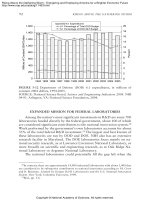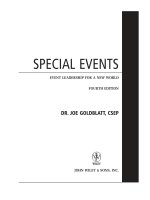Business communication developing leaders for a network world 2nd CHAPTER 3
Bạn đang xem bản rút gọn của tài liệu. Xem và tải ngay bản đầy đủ của tài liệu tại đây (2.69 MB, 34 trang )
Team
Communication
and Difficult
Conversations
Chapter 3
Chapter Overview
Principles of team communication
Approaches to effective meetings
Effective virtual teams
Group writing strategies
Handling difficult conversations
3-2
Most Common Functions of Teams
Handling special projects
Completing the work of particular departments
Developing internal systems innovations
Creating customer-service innovations
Developing product innovations
Engaging in employee development
Reducing time to market for products and services
3-3
Barriers to Team Effectiveness
Ineffective communication
Lack of effective chartering and goal setting
Lack of clarity and goal setting
Low morale
Low productivity
Lack of trust
3-4
Frustrating Aspects of Being Part of a
Team for Business Professionals
Ineffective use of meeting time
Ineffective communication among team
members
Lack of accountability
Individuals who don’t complete assignments
Lack of preparation in meetings
3-5
Principles of Effective Team Communication
Teams should focus first and foremost on
performance
Teams go through four natural stages to reach
high performance
Effective teams build a work culture around
values, norms, and goals
Effective teams meet often - schedule
3-6
Principles of Effective Team Communication
Effective teams embrace differing viewpoints
and conflict.
Effective teams find out the communication
styles and preferences of one another
Effective teams provide a lot of positive
feedback and evaluate their performance often
Effective teams feel a common sense of
purpose
3-7
Stages of Development in
High-Performance Teams
Figure 3.1
3-8
Stages of Development in
High-Performance Teams
Forming stage
Team members focus
on gaining acceptance
and avoiding conflict
Define mission –
Mission Statement
Storming stage
Team members open
up with their
competing ideas
about how the team
should approach work
3-9
Stages of Development in
High-Performance Teams
Norming stage
The team arrives at a
work plan, including
the roles, goals, and
accountabilities –
Team Norms
Performing stage
Teams operate
efficiently toward
accomplishing their
goals
3-10
Principles of Effective Team Communication
Team culture
refers to a set of shared perceptions and
commitment to collective values, norms, roles,
responsibilities, and goals.
3-11
Principles of Effective Team Communication
Team charter
provides direction to
the team in how it
functions to meet
shared objectives.
3-12
Embracing Differing Viewpoints
Inherent diversity
involves traits such as
age, gender, ethnicity,
and sexual
orientation.
Acquired diversity
involves traits you
acquire through
experience, such as
customer service
experience, retail
experience, or
engineering
experience
3-13
Behaviors that Drive Diversity
1. Making sure everyone is heard;
2. Making it safe to let team members express
3.
4.
5.
6.
novel ideas;
Giving team members decision-making
authority;
Sharing credit;
Giving useful feedback
Putting feedback into action.
3-14
Embracing Differing Viewpoints
Disassociation
process by which
professionals accept
critique of their ideas
without taking it
personally and
becoming defensive
Association
psychological bonding
that occurs between
people and their ideas
3-15
Planning for Meetings:
Essential Questions
What is the purpose of the meeting? What
outcomes do I expect?
Who should attend?
When should the meeting be scheduled?
What roles and responsibilities should people
at the meeting have?
3-16
Planning for Meetings:
Essential Questions
What will be the agenda?
What materials should I distribute prior to the
meeting?
When and how should I invite others?
What logistical issues do I need to take care of
(reserving rooms, getting equipment, printing
materials)?
PAL
3-17
Least Productive Parts
of the Workday
Figure 3.5
3-18
Types of Meetings
Coordination
meetings
primarily focus on
discussing roles,
goals, and
accountabilities.
Problem-solving
meetings
typically involve
brainstorming about
how to address and
solve a particular
work problem.
3-19
Creating and Distributing
the Agenda
Agendas provide structure for meetings
Most agendas should include:
items to be covered
time frames
goals and/or expected outcomes
Roles
materials needed.
3-20
Creating and Distributing
the Agenda
Figure 3.6
Sample Meeting Agenda
21
Running Effective Meetings
Create Tradition, Culture, and Variety
Set Expectations and Follow the Agenda
Encourage Participation and Expression of Ideas
Build Consensus and a Plan of Action
Closing the Meeting
Dealing with Difficult People
3-22
Closing the Meeting
All participants reflect:
How much information, analysis, and interpretation
did I provide?
Did I communicate my ideas even if they conflicted
with someone else’s?
Did I participate in the implementation of the
timeline? Did I meet deadlines?
Did I facilitate the decision-making process? Or did I
just go with the flow?
3-23
Following Up After Meetings
Follow up by
distributing the
minutes of the
meeting
Memo, email, team
blog
3-24
Following Up After Meetings
Figure 3.7
Sample Meeting
Minutes
3-25









